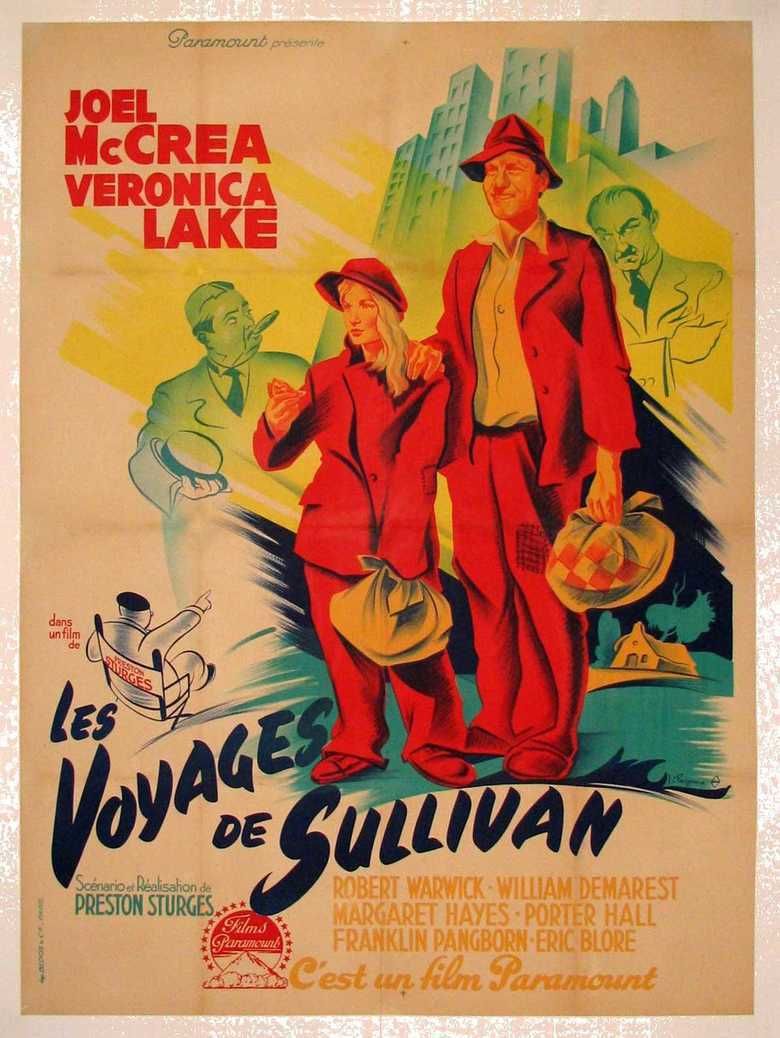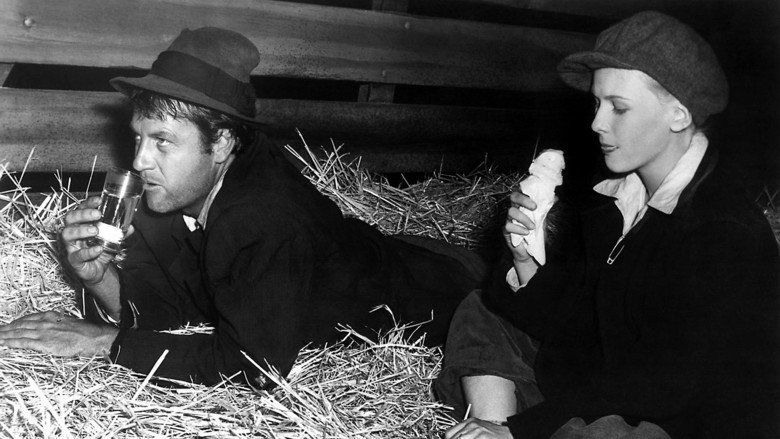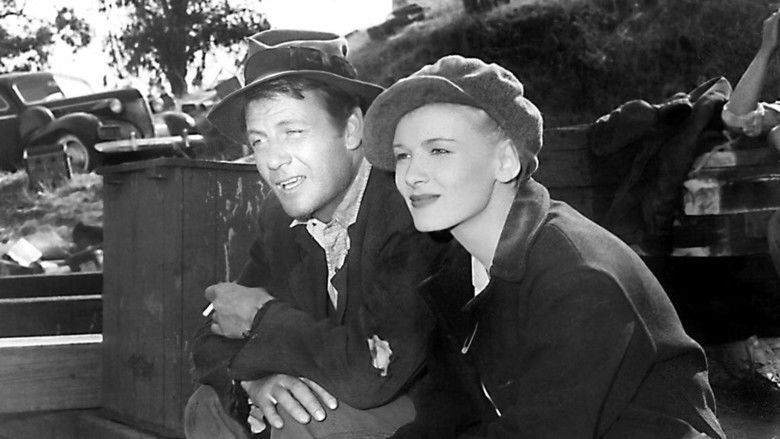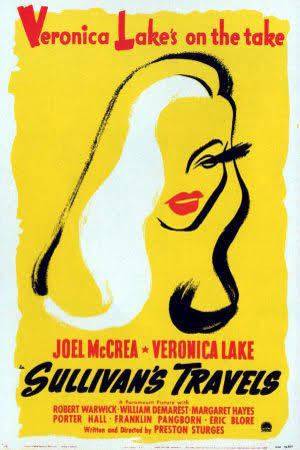Sullivans Travels
8 /10 1 Votes8
Duration Country United States | 8/10 IMDb Genre Adventure, Comedy, Drama Budget 689,665 USD Writer Preston Sturges Language English | |||||||||||||||||||||||||||||||||
 | ||||||||||||||||||||||||||||||||||
Release date January 28, 1942 (1942-01-28) (US) Cast (John L. Lloyd 'Sully' Sullivan), (The Girl), (Mr. LeBrand), (Mr. Jones), (Mr. Casalsis), (Mr. Hadrian) Similar movies Youth , Hugo , Cinema Paradiso , Southland Tales , S1m0ne , Ed Wood Tagline The Creator of "Lady Eve" brings you his latest and most lilting laugh-fest! | ||||||||||||||||||||||||||||||||||
Sullivan s travels official trailer 1 1941 hd
Sullivan's Travels is a 1941 American comedy film written and directed by Preston Sturges. It is a satire about a movie director, played by Joel McCrea, who longs to make a socially relevant drama, but eventually learns that comedies are his more valuable contribution to society. The film features one of Veronica Lake's first leading roles. The title is a reference to Gulliver's Travels, the famous novel by satirist Jonathan Swift about another journey of self-discovery.
Contents
- Sullivan s travels official trailer 1 1941 hd
- Sullivan s travels 7 9 movie clip sully laughs again 1941 hd
- Plot
- Cast
- Production
- Response
- Awards and honors
- Adaptations
- Themes
- In popular culture
- Sullivan s travels 6 9 movie clip sully and the girl 1941 hd
- References

In 1990, Sullivan's Travels was selected for preservation in the United States National Film Registry by the Library of Congress as being "culturally, historically, or aesthetically significant."

Sullivan s travels 7 9 movie clip sully laughs again 1941 hd
Plot

John L. Sullivan (Joel McCrea) is a popular young Hollywood director of profitable but shallow comedies (e.g. Ants in Your Plants). Sullivan is dissatisfied despite his success and tells his studio boss, Mr. Lebrand (Robert Warwick) that he wants his next project to be a serious exploration of the plight of the downtrodden. He asks to make his next film an adaptation of O Brother, Where Art Thou?, a socially conscious novel. Lebrand wants him to direct another lucrative comedy instead, but the idealistic Sullivan refuses to give in. He wants to "know trouble" first hand, and plans to travel as a tramp so he can return and make a film that truly depicts the sorrows of humanity. His butler (Robert Greig) and valet (Eric Blore) openly question the wisdom of his plan.
Sullivan dresses as a penniless hobo and takes to the road, followed by a fully staffed double-decker coach at Lebrand's request. Neither party is happy with the arrangement; and Sullivan eventually persuades his guardians to leave him alone and arranges to rendezvous with them in Las Vegas later. However, when he hitchhikes alone, he finds himself back in Los Angeles where he started.
There he meets a young failed actress (Veronica Lake, identified only as "The Girl") who is just about to quit the business and go home. She believes he is truly a tramp, and buys him a breakfast of eggs and ham. In return for her kindness, Sullivan retrieves his car from his estate and gives her a lift. He neglects to tell his servants that he has returned; so they report the "theft" of the car and Sullivan and the Girl are apprehended by the police. Upon their release, the Girl pushes him into his enormous swimming pool for deceiving her about his true identity. However, after considering her options, she becomes his traveling companion.
This time Sullivan succeeds in living like a hobo. After eating in soup kitchens and sleeping in homeless shelters with the Girl, Sullivan finally decides he has had enough. His experiment is publicized by the studio as a huge success. The Girl wants to stay with him, but is stymied by his complicated living situation. On the advice of his business manager, Sullivan had gotten married to reduce his income tax. Ironically, he discovers that his wife cost him double what he saved in taxes.
Sullivan decides to thank the homeless by handing out $5 bills, but one man, who had previously stolen his shoes, ambushes Sullivan and steals the money. Sullivan is knocked unconscious and thrown onto a boxcar leaving the city. The thief drops the loose cash on the rails, getting run over and killed by another train while picking it up. When the thief's body is found, they discover a special identification card in his shoes identifying him as Sullivan. The mangled body is assumed to be Sullivan's, and his staff and the Girl are informed of his death.
Meanwhile, Sullivan wakes up in the rail yard of another city, with no memory of who he is or how he got there. In his confused state, he assaults the railroad worker who finds him, for which he is sentenced to six years in a labor camp. Sullivan slowly regains his memory. While in the labor camp, Sullivan attends a showing of Walt Disney's Playful Pluto cartoon. Looking at the pure joy in the audience's faces, Sullivan realizes that comedy can do more good for the poor than his proposed social drama, O Brother, Where Art Thou?.
But Sullivan still has a problem – he cannot convince anybody that he is Sullivan. Finally, he comes up with a solution: he confesses to being his own killer. When his picture makes the front page of the newspapers, the Girl recognizes him and gets him released. His "widow" had already taken up with his crooked business manager, so he can now divorce her and be reunited with the Girl. A montage of happily laughing faces ends the film.
Cast
Cast notes:
Production
Paramount purchased Sturges's script for Sullivan's Travels for $6,000. He wrote the film as a response to the "preaching" he found in other comedies "which seemed to have abandoned the fun in favor of the message." Sturges may have been influenced by the stories of John Garfield, who lived the life of a hobo, riding freight trains and hitchhiking his way cross country for a short period in the 1930s. Sturges wrote the film with Joel McCrea in mind, but found the female lead through the casting process. Barbara Stanwyck was considered, as well as Frances Farmer.
The film as released opens with a dedication:
To the memory of those who made us laugh: the motley mountebanks, the clowns, the buffoons, in all times and in all nations, whose efforts have lightened our burden a little, this picture is affectionately dedicated.
This was originally intended to be spoken by Sullivan. Sturges wanted the film to begin with the prologue: "This is the story of a man who wanted to wash an elephant. The elephant darn near ruined him." Paramount contracted with the Schlesinger Corp., who made the Warner Bros. Looney Tunes and Merrie Melodies cartoons, to make an animated main title sequence, but this was not used in the film, if it was ever actually produced.
The censors at the Hays Office had objections to the script which the studio submitted to them. They felt that the word "bum" would be rejected by British censors, and warned that there should be no "suggestion of sexual intimacy" between Sullivan and The Girl in the scenes in which they are sleeping together at the mission.
Sullivan's Travels went into production on 12 May 1941 and wrapped on 22 July. Location shooting took place in Canoga Park, San Marino, Castaic and at Lockheed Air Terminal.
Veronica Lake was six months pregnant at the beginning of production, a fact she didn't tell Sturges until filming began. Sturges was so furious when he learned that, according to Lake, he had to be physically restrained. Sturges consulted with Lake's doctor to see if she could perform the part, and hired former Tournament of Roses queen Cheryl Walker as Lake's double. Edith Head, Hollywood's most renowned costume designer, was tasked to find ways of concealing Lake's condition. Reportedly, Lake was disliked by some of her co-stars; McCrea refused to work with her again, turning down a lead role in I Married a Witch, and Fredric March, who got the part, didn't get along with her as well. McCrea got along famously, however, with Sturges, and afterward presented him with a watch engraved "for the finest direction I've ever had." Sturges' assistant director, Anthony Mann, was also heavily influenced by the production.
There were some minor problems during filming. Sturges had wanted to use a clip from a Charlie Chaplin film for the church scene, but was turned down by Chaplin. McCrea does parody Chaplin's "Little Tramp" character earlier in the film. Also, the "Poverty Montage" was scheduled to take three hours to film, but instead took seven hours. Incidents such as this may account for the film, which cost more than $689,000 to produce, going more than $86,000 over budget.
The film was first screened for critics on December 4, 1941. It had its first public screening in the US on January 15, 1942, in Detroit. Its Hollywood premiere occurred two weeks later on February 12, 1942, at the Los Angeles Paramount Theatre.
When the film was released, the U.S. government's Office of Censorship declined to approve it for export overseas during wartime, because of the "long sequence showing life in a prison chain gang which is most objectionable because of the brutality and inhumanity with which the prisoners are treated." This conformed with the office's standing policy of not exporting films which could be used for propaganda purposes by the enemy. The producers of the film declined to make suggested changes which could have altered the film's status.
Sullivan's Travels was released on video in the U.S. on 16 March 1989, and re-released on 30 June 1993. The film was re-released in the UK with a restored print on 12 May 2000.
Response
Sullivan's Travels was not as immediately successful at the box office as earlier Sturges films such as The Great McGinty and The Lady Eve, and received mixed critical reception. Although the review in the New York Times called the film "the most brilliant picture yet this year" and praised Sturges's mix of escapist fun with underlying significance, The Hollywood Reporter said that it lacked the "down to earth quality and sincerity which made [Sturges's] other three pictures a joy to behold" and that "Sturges...fails to heed the message that writer Sturges proves in his script. Laughter is the thing people want—not social studies." The New Yorker's review said that "anyone can make a mistake, Preston Sturges, even. The mistake in question is a pretentious number called Sullivan's Travels." Nevertheless, the Times named it as one of the "10 Best Films of 1941", and the National Board of Review nominated it as best picture of the year.
Over time, the reputation of the film has improved tremendously, and it is now considered a classic; at least one reviewer called it Sturges's "masterpiece" and "one of the finest movies about movies ever made." It has a 100% approval rating on Rotten Tomatoes, with an average rating of 8.7/10.
Awards and honors
In 1990, Sullivan's Travels was selected for preservation in the United States National Film Registry by the Library of Congress as being "culturally, historically, or aesthetically significant." In 2007, the American Film Institute ranked it as the #61 Greatest American Movie of All Time. In addition, the movie's poster was ranked as #19 of "The 25 Best Movie Posters Ever" by Premiere. A 2010 special issue of Trains magazine ranked Sullivan's Travels 25th among "The 100 Greatest Train Movies."
The film is recognized by American Film Institute in these lists:
The two Writers Guilds of America voted the screenplay for Sullivan's Travels as the 29th greatest ever written, as well as the 35th funniest.
Adaptations
On November 9, 1942, Lux Radio Theatre broadcast a radio adaptation of Sullivan's Travels with Ralph Bellamy in the lead role and Veronica Lake reprising her role.
Themes
The theme of the film is best summed up in the film's last line of dialogue as spoken by Sullivan, ""There's a lot to be said for making people laugh. Did you know that's all some people have? It isn't much, but it's better than nothing in this cockeyed caravan."
The scene where the prisoners are taken to watch the Disney cartoon Playful Pluto takes place in a Southern African-American church; the film notably treats the African-American characters there with a level of respect unusual in films of the period. The Secretary of the NAACP, Walter White, wrote to Sturges:
I want to congratulate and thank you for the church sequence in Sullivan's Travels. This is one of the most moving scenes I have seen in a moving picture for a long time. But I am particularly grateful to you, as are a number of my friends, both white and colored, for the dignified and decent treatment of Negroes in this scene. I was in Hollywood recently and am to return there soon for conferences with production heads, writers, directors, and actors and actresses in an effort to induce broader and more decent picturization of the Negro instead of limiting him to menial or comic roles. The sequence in Sullivan's Travels is a step in that direction and I want you to know how grateful we are.
In popular culture
In the airplane scene in Sullivan's Travels, the author of the book O Brother, Where Art Thou? is shown to be "Sinclair Beckstein", which is an amalgamation of the names of authors Upton Sinclair, Sinclair Lewis, and John Steinbeck, all of whom wrote socially conscious fiction. The title of Sullivan's unrealized dream project has resurfaced in several other works.
Sullivan s travels 6 9 movie clip sully and the girl 1941 hd
References
Sullivan's Travels WikipediaSullivans Travels IMDb Sullivans Travels themoviedb.org
